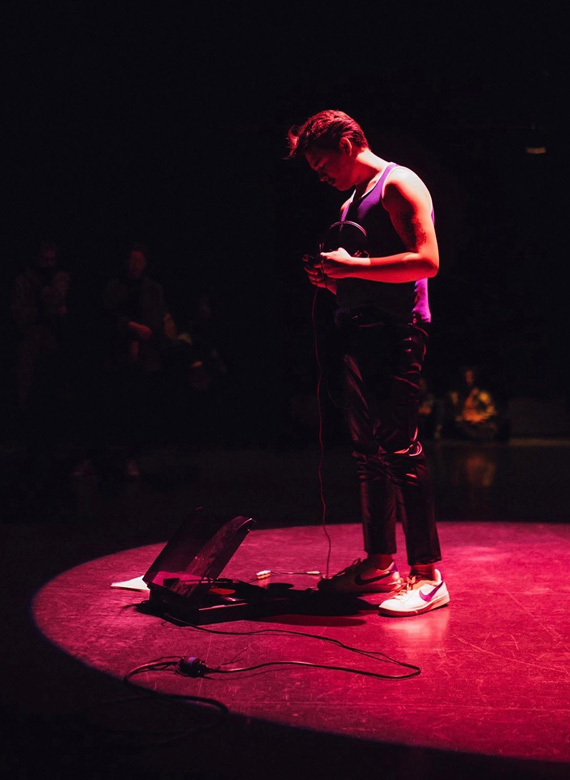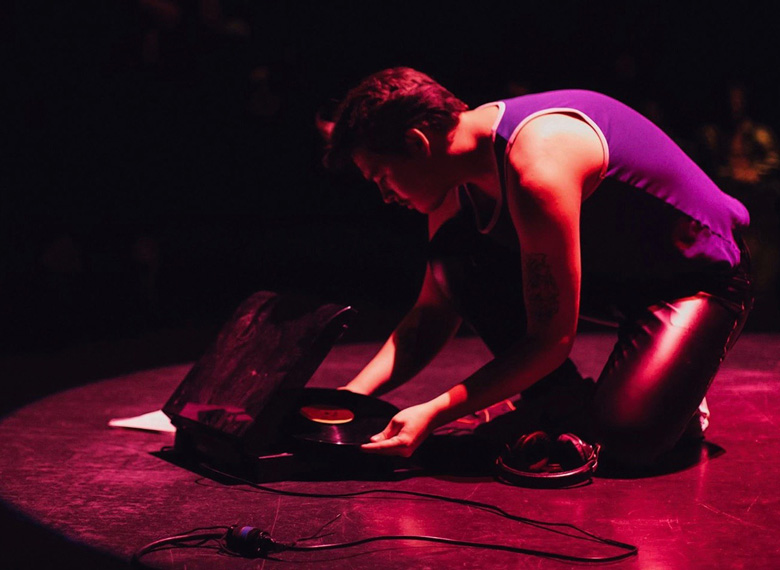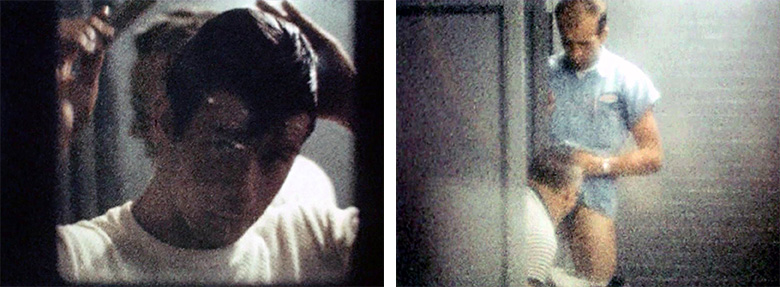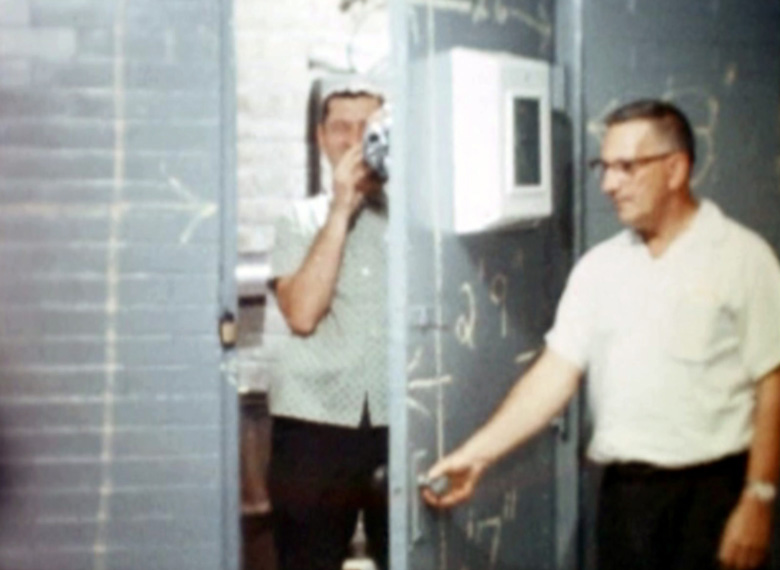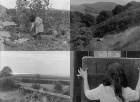Two months prior to Ryan Danny Owen’s performance of Love Me Like There’s No Tomorrow at the 9th Biennial M:ST Performative Art Festival in Calgary, I was drunkenly stumbling off a New York subway car with a new copy of Jack Halberstam’s Female Masculinity1tucked under my arm. I waved back to Ryan, who was still on the train, and chirped, “Get home safe!”. Glancing back, I caught sight of Ryan’s smiling face framed by their floppy dark hair and two closing subway doors.
For years, Ryan and I had been on the peripheral of one another’s social and professional lives (we both attended the Alberta College of Art and Design and graduated within a year of each other). But it was only this past summer, while I was in New York attending a two month residency,2that we finally spent some time together. Two days prior to leaving the community resources of New York and its incredible queer histories, I wanted to go to the Village to find the Gay and Lesbian Centre which housed the BoGSQD3bookstore and Keith Haring’s Once Upon a Time (1989) bathroom mural. I was being led by my Brooklyn roommate Lucy who was training to be a New York tour guide and wanted to practice her Stonewall tour. Afterwards, we were planning on dropping in to one of my favourite places in New York: The Fat Cat jazz bar.
That morning, Ryan sent me a message out of the blue. They said that they were also in New York for a few days and asked if I would like to go for a drink, if I wasn’t too busy. I realized that “If you aren’t too busy” was a heartwarming Canadian sentiment that I had missed while away. In a typical New Yorker move I replied with my already-full itinerary and an invitation: “Do you want to come with?” The night ended nine hours later with both of us very, very drunk and each with numbers from a couple of chatty New Yorkers we met while smoking outside the jazz bar.
Throughout our day together in New York, Ryan told self-deprecating jokes and surprised me by always having something new to add to the research I was doing on New York’s queer histories. I wondered, “Why haven’t I talked to this person before? And why not in Calgary?” It felt fated that I would end my summer stint amongst historic back alleys, trash, and speed-walking New Yorkers by getting shit-faced with a fellow tender-hearted Canadian.
Two months later Ryan’s Nike-checked sneakers squeaked on Calgary’s Theatre Junction GRAND’s black-painted floor as they slid, twirled, and shimmied within a round pool of rosy spotlight in their Love Me Like There’s No Tomorrow performance. A long cord connecting a record player to headphones trailed behind them as they lip-synched to a song only they could clearly hear. I couldn’t help but smile as I listened to Ryan wheeze along to the faint sounds of Freddie Mercury’s voice in a chorus of yearning. Spread out around the perimeter of the large, darkened space was a crowd of completely silent observers, save for the occasional coughing or shuffling as someone adjusted their weight. When you ask a crowd to watch you silently lip synch to an entire forty-six minute rendition of Mercury’s Mr. Bad Guy album, it’s fair to have some crowd shuffling.
Ryan performed Love Me Like There’s No Tomorrow for the M:ST (Mountain Standard Time) Performative Art Festival, a biennial event that coordinates collaborations between numerous art and performance organizations throughout southern Alberta, often for a duration of several weeks. Ryan’s artist statement for the performance introduced the singer/songwriter Freddie Mercury by his often-unknown birth name Forrokh Balsara, citing the singer’s Parsi heritage and the racial erasure that has for so long surrounded his Western persona. Ryan’s statement describes how Mercury, after dying from AIDS related complications, requested his final resting place remain unknown to his family, friends, and fans. Ryan writes, “Despite continuous public efforts to find Freddie’s grave, its location has remained a mystery to this day.”4
Often, as queer people, we relate to the tragedy of someone as much as we do the beauty of their music and art. Mercury is certainly one of those figures. While untimely celebrity death is something that many people are fascinated by, it’s often the ongoing struggles within their lifetimes (and perhaps their triumph over them) that queers connect to and glamorize. However, I wouldn’t describe Ryan’s M:ST performance as glamorizing Mercury and the memory of his music. Rather, Love Me Like There’s No Tomorrow offers the possibility for a different kind of memory-keeping: the performed monument. Unlike the stationary and permanent sculptures or installations we are used to, using a durational performance as a medium for the monument forces the audience to consider the subject of memorial under the contemporary contexts it is being shown in (including political), and who is performing it.
Ryan’s performance offered a type of commemoration that forces contemporary contextualization. When a celebrity, who has passed some years ago, is being commemorated by a living body, it makes us consider why the struggles they went through are still important enough to need to be performed by someone living today.
The heart-wrenched sounds of a voice belting out a lyric that insists on overcoming obstacles, (the greatest pop-culture export of Mercury that we have) is contradicted in this alternative format of memorial. In contrast to Mercury and our collective value placed on his voice, Ryan’s memorial was almost silent. During Love Me Like There’s No Tomorrow, the audience’s only means to connect to Mercury through sound were the barely-discernible tones leaking from the headphones. Rarely could you catch Mercury and only between Ryan’s gasps for air, the smacking of their lips as they synched their mouth to a consonant, and the rubbery shuffles of Nike’s on the dance floor. Ryan’s performance offered a type of commemoration that forces contemporary contextualization. When a celebrity, who has passed some years ago, is being commemorated by a living body, it makes us consider why the struggles they went through are still important enough to need to be performed by someone living today.
Twenty-or-so minutes into the performance, Ryan’s exhaustion became obvious. Their once concise, bouncing, and energized dancing eventually waned into a heavy fluidity that only a slow and stumbling, truly tired body can have. As an audience member, your mourning of the public figure of Mercury re-ignites as you empathize with both Ryan’s and Mercury’s endurance in performing their bodies. If this were a conventional monument, we could resign ourselves to Mercury’s death and the tragedy of AIDS as something that happened in the past. But while watching a performed monument we instead connect the past and current reality’s shared aspects. In this case, it is the bodily awareness that queer people endure and express, regardless of the era.
The emotional toll Love Me Like There’s No Tomorrow had taken on Ryan was easy to observe. After the record player’s needle finished tracing its way across the black topography of Mr. Bad Guy, Ryan discreetly stopped dancing. No token Mercury-style fist to the sky was used for a climax and instead they only started packing away the record player. Their hands shook as they slipped the vinyl back into its sleeve, slid off the headphones, and walked hurriedly away from the pink limelight and over to the shadowed stage door. Now that headphones and a pair of tightly closed eyelids weren’t shielding them, they were no longer consenting to our observation of their body and made a quick exit.
This sudden shift drove home Ryan’s mastery in using their performance as a metaphor for queer living: how quickly our consent to be seen can transform into a refusal of being watched. Queer artistic and political (public) performances of visibility can eventually jump to the reality of finding a good hiding spot; expression is fought for, but safety is instinctual. Ryan’s narrative of a performing queer body being seen and unseen is an apt description for our desire of inclusion and exclusion on our own terms. It also offers a potential reason for Mercury’s refusal to have his body’s resting place be known. The performance of Love Me Like There’s No Tomorrow was an articulate response to the music Mercury performed within his lifetime, as well as his later refusal for his body to perform in death. By insisting his resting place be unknown, he ultimately made the choice to no longer be seen.
Ryan’s narrative of a performing queer body being seen and unseen is an apt description for our desire of inclusion and exclusion on our own terms.
In the days leading up to Ryan’s performance, I was able to finally visit their studio in Calgary, as we had planned together months prior in New York. It was littered with cutouts from vintage porn mags and papers with phrases scrawled on them in thick black ink such as, “DANCE HERE FOREVER WITHOUT FEAR”. They had collaged and manipulated the found photos of gay cis-male porn stars, obstructing identifying features or erasing the genitals, leaving only the piercing gaze of the model to connect to. After Ryan served me numerous cups of black coffee and three hours of talking, they showed me a surrealist 1982 gay porno titled Turned On! that they had recently found while researching. Together we were mesmerized while scrutinizing the porno: at seeing such artistic lighting, so many fog-machines, and the numerous psychological plot twists in a type of filming now known for its crudeness and get-to-the-point quality. Under the watchful eyes of the collages, and surrounded by the queer ephemera of their studio, it felt normal for Ryan and I to be sifting through retro masc porn together.
“Wait, you have to see this one too, ” Ryan urged. They paused Turned On!, with its accompanying tracks of disco and early synth, and clicked over to another link they had saved. Ryan showed me what looked like a very real and soundless video that had been secretly caught in a public washroom where gay men were having anonymous sex. An act that, telling by the dress of the men and quality of the footage, was illegal at the time. I asked, “How did you find this? This is amazing.” Ryan replied, “I know, I just found it on another gay porn website.”
It was only after leaving Ryan’s studio and researching the video myself, that I found its origins. In 1962 the Mansfield, Ohio police organized the covert filming of a public washroom within one of the city’s parks that was known for cruising. Gay men used the washroom as a way to have consensual, anonymous sex away from the eyes that would persecute their actions under social conventions and the law. The 16mm film begins with documentation of the washroom’s location in the park, designated by a stairwell leading down below a large sign reading, “GENTLEMEN”. The dark interior of the washroom and its stalls are shown, followed by a close-up of the slow insertion of an index finger into a hole carved into the wall of a stall. The anonymous masculine hand (with a heavy silver watch and gold marriage ring) shows us how a glory hole works. The capturing of the washroom’s dark landscape is so extensive that it becomes foreboding. It doesn’t feel like a director is setting a scene, but rather the documentation of a trap being set. This is confirmed when the first figures we do see are the plain-clothes cops demonstrating the two-way mirror they are going to hide behind. The video then displays the footage the police captured of various men of different backgrounds performing oral and anal sex, giving hand jobs, and some just walking around the washroom observing each other.
Los-Angeles based artist and film director William E. Jones used this 1962 Mansfield footage for his video works Mansfield (2006) and Tearoom (2007). Jones created Mansfield after finding a degraded version of the footage online. He first presented the footage within gallery and museum spaces virtually unaltered. A year later, Jones searched out the original celluloid footage and from it created the digital and colour-quality Tearoom. Watching Jones’s film and the original footage is a surreal and conflicting experience. It’s an invaluable document of queer phenomenon, and it’s deeply interesting to watch these early 1960s ad-men, greasers, and blue collar labourers consent to one another’s sexual gaze. A seemingly egalitarian environment of sexual action appears unconcerned with age, race, or class appearances. Due to the evidentiary filming style, it is clear that the opportunity to view these events is only possible through the cops’ non-consensual surveillance tactics. The footage is an epiphany of queer sexuality for providing historical precedence of queer lives in the 1960s as well as a tragedy. It was later used in court to charge the subjects of the film with sodomy and sentence them to time in prison.
Jones has exhibited the unedited, soundless footage at numerous exhibitions across the world, including the 2008 Whitney Biennial. Rather than editing the footage, the impact of Jones’s showing the videos was in their re-contextualization. Instead of a courtroom where the men on film were portrayed as perverts, now it is the police and the institution they worked for that may be antagonized by gallery goers. The harm done to these men in the past is highlighted and so is our new contemporary sense of injustice committed against them. Jones’s website describes Tearoom as “a radical example of film presented ‘as found’ for the purpose of circulating historical images that have otherwise been suppressed.”5His work has since been pirated and made its way onto numerous gay porn websites, where Ryan was later able to find it.
The original footage and their re-contextualizing in Jones’s artworks are similar to the effect of Ryan’s performed monument. Both artists emphasize the constant awareness a queer person has of their body being observed by others, while demonstrating how this is a feeling that has been felt by queer people throughout generations. Like Ryan and Mercury, the subjects of the Mansfield film were handed two possible options in order to act upon their identity: to perform themselves or to refuse themselves to others. For the men in the Mansfield washroom, they attempted to refuse the public’s witnessing of their actions, but were instead forced by the police into the public domains of the court.
The years between the Mansfield footage being taken, Mercury’s career and death, and Ryan’s M:ST performance can serve as a timeline for the different ways that queer people have navigated the push-and-pull between performing and hiding oneself. Love Me Like There’s No Tomorrow is a monument to Mercury’s talent and death. Due to its performative nature it also illustrates and commemorates the history of queer people deciding when they do or don’t consent to their actions and bodies becoming a spectacle.
Throughout his prolific career Mercury performed his body and its voice for a world audience, and in death refused that performance entirely. The cruisers from the Mansfield washroom never intended their bodies to be seen, but were forced to become recognized for them by a public. Love Me Like There’s No Tomorrow serves as a monument to this consistent awareness of performativity that queer people have grappled with for generations. The M:ST Performative Art Festival’s commitment to providing a diverse range of voices made it possible for Ryan to present a style of monument that, because of its alternative nature, describes both past and current queer struggle. Love Me Likes There’s No Tomorrow is a clear fruition of the subjects we had bonded over while touring the Village in New York together, earlier this past summer: the history, awareness, and resilient self-making integral to identifying with the label “Queer”.
Anj Fermor is the recipient of the M:ST & Luma Quarterly Critical Writing Prize.
Anj Fermor is an artist and writer residing in Calgary, Alberta on Treaty 7 Territory. They have provided art work and writing for exhibitions throughout Calgary. This past summer they participated in the New York University Summer Studio Residency, was a finalist for the 20th Annual RBC Painting Competition, and in 2019 will be aresident for the Calgary Allied Arts Foundation at cSPACE King Edward. Much of Fermor’s artwork and texts document the significance of self-isolation as a tool for identity-making.


